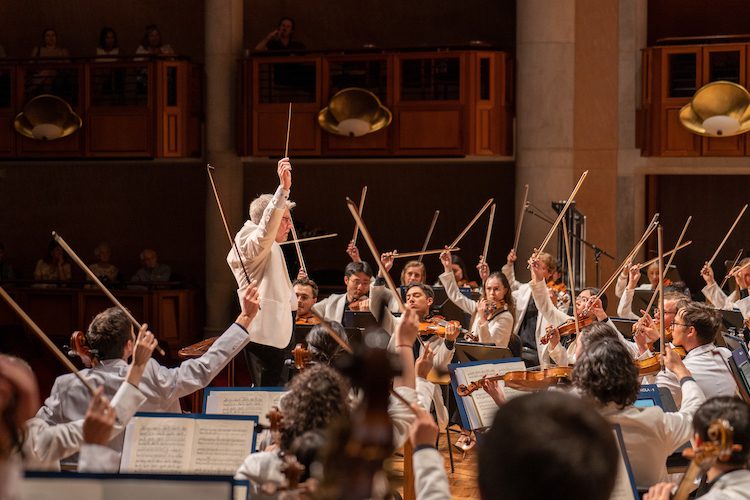There is no shortage of world-renowned hits in this season’s nature-inspired programming, but National Repertory Orchestra Director of Operations and Education Dan Howard is most excited about the lineup’s ‘hidden gems.’
“There are always the barn burners – Ravel’s Bolero, Gustav Holst’s The Planets, Beethoven’s “Pastorale” – the big ones people love and come to hear,” says Howard, a musician himself who has played in orchestras all over the world. “It’s always great to hear something familiar, but some of these deep cuts have the potential to become new favorites.”
June 29: Sibelius’ The Oceanides & Tchaikovsky’s Symphony No. 2
Looking at the expansive summer lineup, Howard first points to a couple of such pieces bookending the June 29 concert. The Oceanides, by Jean Sibelius, opens the performance.
“Sibelius is a known composer. People are familiar with his work,” Howard points out. “This is a tone poem. It’s very nationalist for him, for Finland, about the world he grew up in. In this piece, you hear the sea. One thing special about Sibelius is how full he makes the orchestra sound. He does a good job filling out the sound as he’s telling the story, but it’s not overpowering. It’s like when you put on a heavy quilt—while a lighter blanket that’s taken from the dryer fills you with its warmth immediately, a heavy quilt provides a subtle, lasting sense of comfort. This piece is like that.”
The June 29 performance ends with a lesser-known piece by Piotr Ilyich Tchaikovsky – Symphony No. 2.
“Everyone knows Tchaikovsky’s Symphonies 4, 5 and 6. Symphony No. 2… talk about a real gem. A true gift that Tchaikovsky had was to make things sound instantly familiar, like “Sleeping Beauty,” “The Nutcracker” or “Swan Lake.” Symphony No. 2 is so much fun to listen to, and so much fun to play. It’s based almost entirely on Ukrainian folk music, and less programmatic than some of his other work. Being a trombone player, I like how he writes for the low brass section. Those instruments are a real partner in the conversation. The first time I heard it, I remember thinking, this is amazing. It really is a hidden gem,” Howard says.
July 24: Debussy’s Ibéria
Leading into guest conductor Matthias Pintscher’s finale of Bolero on July 24 is a rare, jaunty piece by Claude Debussy, Ibéria from Images for Orchestra that paints an auditory journey of Spain.
“There are three short movements of this piece and you really feel like you’re walking along the festive streets going to a celebration,” Howard says. “Debussy always hated being compared to painters like Monet, but this really is an impressionistic style of writing music. It tells a story without using words. He takes melodies when they stand by themselves and somehow puts them together and it makes perfect sense.”
July 31: Ginastera’s Harp Concerto
After Grammy-nominated guest conductor Karina Canellakis kicks off this concert with the tour de force that is Johannes Brahm’s Symphony No. 3, the audience is once again in for a rare treat with Ginastera’s Harp Concerto.
“It’s unusual to put the big, major symphony on the front of the program,” Howard points out. “You typically do a concerto and lead into it. Here, we flipped it. We’ll start with the big masterwork, take a break, let people catch their breath and then switch gears into the Ginastera Harp Concerto. Brahms is the kind of guy who asked his audiences to sit quietly, but in Ginastera, you’ll get a tango, a dance. You’ll see the audience’s reaction, having a visceral response. It will be a surprise, for sure.”
Aug. 10: Frank’s Contested Eden
Some of the best surprises, however, will be the works of younger composers sprinkled into this summer’s mix, most of whom NRO Music Director Michael Stern knows personally. One powerful example on display during the season finale Aug. 10 is Contested Eden by composer Gabriela Lena Frank.
“This piece is about the California wildfires. It talks about the love of the forest, the love of a place, love of the scenery and the sadness when it goes away. The music is young, but it has the strength and quality of masterwork. It hasn’t yet had the 200 years to settle in people’s hearts,” Howard says.
The most thrilling element of the season’s hidden gems, Howard believes, is the fact that the young members of the orchestra will approach these pieces with fresh eyes and fresh talent.
“One of my favorite things about the summer festival is when the orchestra plays something most of them have never played before,” he says. “They have different backgrounds, different exposures, different histories and different training. The majority of them have not played these works, so a piece sounds like what it might have the first time it was ever played. There’s a special energy to that.”
Photo by Joshua Geurink.
